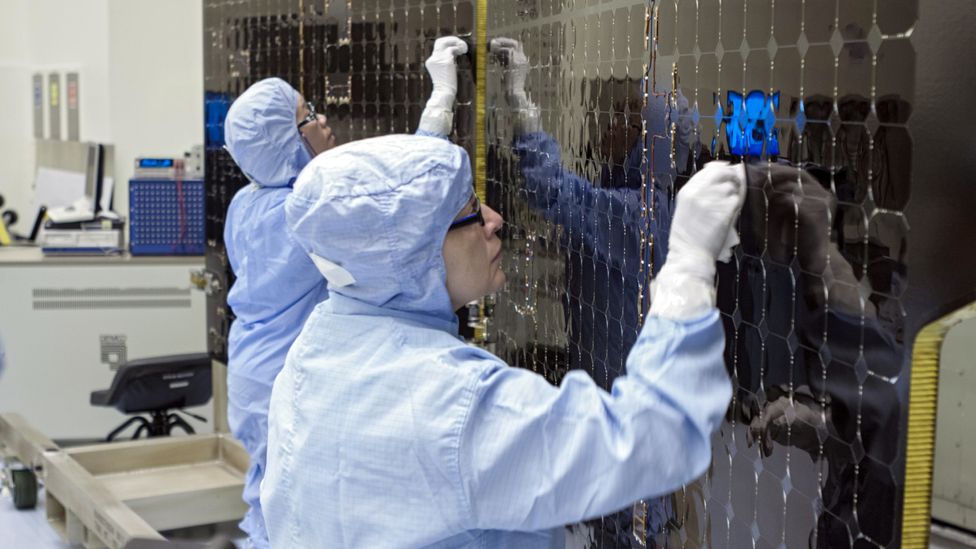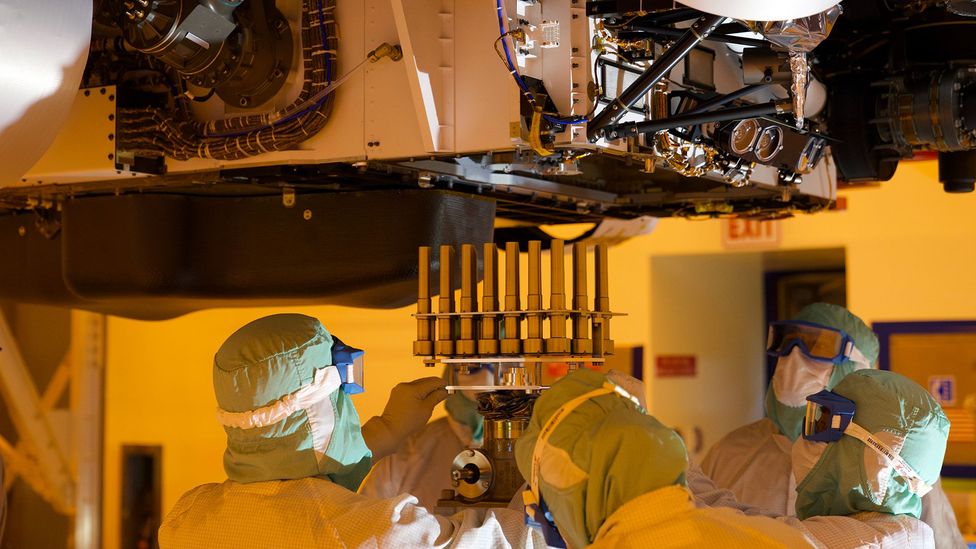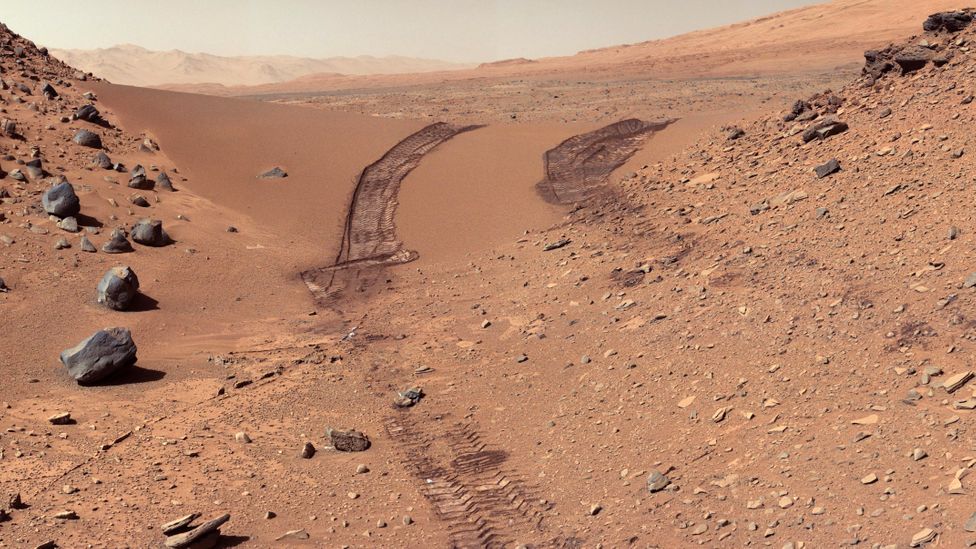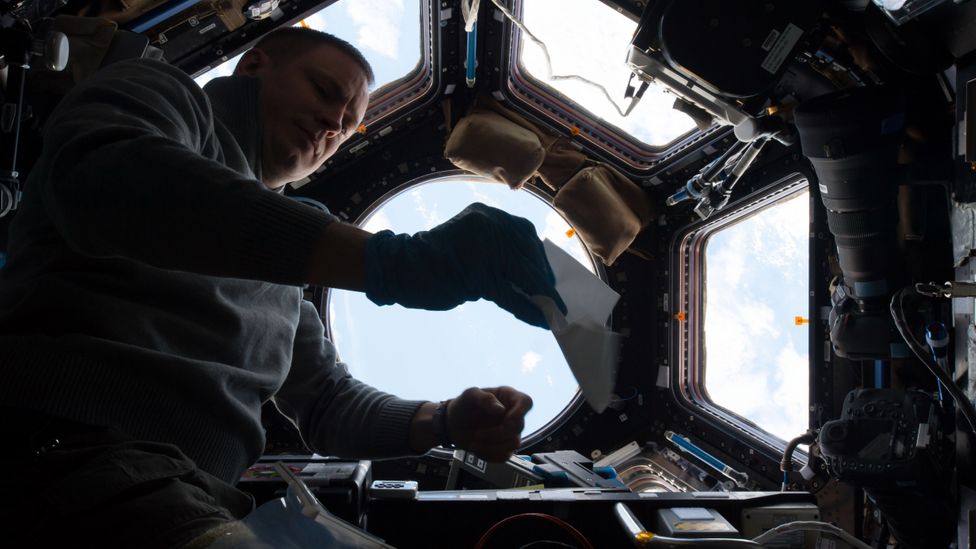Trundling across the surface of Mars as you read this is a remarkable machine. Perseverance – the car-sized rover that safely touched down on the Martian surface on 18 February this year – might only have a top speed of less than 0.1 miles per hour (152m/hr), but it carries a wide range of tools, instruments, and experiments that have already made some groundbreaking achievements.
Included on board the 10ft-long (3m) rover is a machine that has turned the thin, carbon dioxide-rich Martian air into oxygen and a helicopter the size of a tissue box that made the first-ever powered, controlled flight on another planet. The helicopter, called Ingenuity, has now made three successful flights, each longer and higher than the last.
But did anything else come along for a ride with all this hardware? Could a trace bacterium or spore from Earth have accidentally been carried into space and survived the trip to make its new home on Mars?
Although Nasa and its engineers in the Jet Propulsion Laboratory (JPL) have precise and thorough protocols to ensure their spacecraft are free from any organisms that might inadvertently hitchhike on a space mission, two recent studies highlight how some organisms might have survived the cleaning process and also the trip to Mars, and also how fast microbial species can evolve while in space.
First, let's start with the process that was required to build the Perseverance rover, as well as most spacecraft made in JPL's spacecraft assembly facility (SAF). There, spacecraft are painstakingly built one layer at a time, like an onion, with everything cleaned and sterilised before it is added. These methods ensure that almost no bacteria, viruses, fungi, or spores contaminate the equipment to be sent on a mission.

Spacecraft undergo rigorous cleaning as they are assembled and prepared for launch to other planets (Credit: NASA/Jim Grossmann)
Spacecraft are built in ISO-5 clean rooms (where ISO-1 denotes cleanest facilities and ISO-9 are least clean) with air filters and strict biological control procedures. These are designed to ensure that only a few hundred particles can contaminate each square foot and ideally no more than a few dozen spores per square metre.
But, it is almost impossible to get to zero biomass. Microbes have been on Earth for billions of years, and they are everywhere. They are inside us, on our bodies, and all around us. Some can sneak through even the cleanest of clean rooms.
In the past, tests for biological contamination have relied upon the ability to grow (often called culturing) life from samples swabbed from equipment. The newer methods used by my colleagues and I take a given sample, extract all the DNA, and then "shotgun" sequence it. As the term implies, it is like taking a shotgun to the cells of a sample, blasting them into billions of small DNA fragments, and then sequencing each piece. Each piece (or sequence "read") can then be mapped back to the known genomes of species that are already present in sequence databases.
Since we can now sequence all the DNA that is present in the clean rooms, and not just the ones that could be cultured, we get a more comprehensive look at what kind of microbes can be found in the clean room, and if they could even survive the vacuum of space.
In JPL's clean rooms, we found evidence of microbes that have the potential to be problematic during space missions. These organisms have increased numbers of genes for DNA repair, giving them greater resistance against radiation, they can form biofilms on surfaces and equipment, can survive desiccation and thrive in cold environments. It turns out that clean rooms might serve as an evolutionary selection process for the hardiest bugs that then may have a greater chance of surviving a journey to Mars.
These findings have implications for a form of planetary protection called "forward contamination". This is where we might bring something (accidentally or on purpose) to another planet. It is important to ensure the safety and preservation of any life that might exist elsewhere in the Universe, since new organisms can wreak havoc when they arrive at a new ecosystem.

Nasa has stringent clean room protocols that aim to minimise biological contamination of spacecraft and landers (Credit: Nasa/JPL-Caltech)
Humans have a poor track record of this on our own planet. Smallpox, for example, was spread on blankets given to Indigenous people of North America in the 19th Century. Even in 2020, we have been unable to contain the rapid spread of the virus that causes Covid-19, SARS-CoV-2.
You might also like:
- The weird space outside our solar system
- How a switch saved a Moon mission
- The giant plant astronomers can't find
Forward contamination is undesirable from a scientific perspective too. Scientists need to be sure that any discovery of life on another planet is genuinely native there, rather than a false identification of an alien-looking, but Earth-grown, contamination. Microbes could potentially hitchhike their way to Mars, even after radiation and sterilisation procedures, and their genomes may change so much that they look truly otherworldly, as we have recently seen with microbes that evolved on the International Space Station. If these types of species were found in the Martian soil, it could potentially spark misguided research into the universal features of life or Martian life.

Humankind has sent dozens of spacecraft and landers to Mars – those that have been successful have left their mark on the Red Planet (Credit: NASA/JPL-Caltech/MSSS)
Microbes carried into space can also be of more immediate concern to astronauts – posing a risk to their health and perhaps even causing life-support equipment to malfunction if they become gummed up with colonies of microorganisms.
But planetary protection is bidirectional. The other component of planetary protection is avoiding "backward contamination", where something brought back to Earth presents a risk to life on our own planet, including to humans. This is the theme of many science-fiction movies, where an evil "alien" invader threatens all life on Earth. But when a Nasa and the European Space Agency mission is launched towards Mars in 2028, it could become a very real issue – if all goes according to current plans, the Mars Sample Return Mission will bring back the first Martian samples to Earth in 2032.
There is already a chance, however, that if we do detect signs of life on Mars, it could have come from Earth in the first place. Ever since the first two Soviet probes landed on the Martian surface in 1971, followed by the US Viking 1 lander in 1976, there likely have been some fragments of microbial, and maybe human DNA, on the Red Planet. Given the global dust storms and trace amounts of DNA that might have gone with these spacecraft, we have to be sure we don't fool ourselves that the life we find isn't originally from Earth.
But even if Perseverance – or the missions that preceded it – did accidentally carry organisms or DNA from Earth to Mars, we have ways of telling it apart from any life that is truly Martian in origin. Hidden within the DNA sequence will be information about its provenance. An ongoing project called Metasub (metagenomics of subways and urban biomes) is sequencing the DNA found across more than 100 of the world's cities, Researchers from our lab, Metasub teams, and a group in Switzerland have just published these and other global metagenomic data to create a "planetary genetic index" of all sequenced DNA that has ever been observed.
By comparing any DNA found on Mars to sequences seen in the clean rooms of JPL, the subways of the world, clinical samples, wastewater, or the surface of the Perseverance rover before it left Earth, it should be possible to see if they are truly novel.
Even if our exploration of the Solar System has inadvertently carried microbes to other planets, it is likely they will not be the same as it was when it left the Earth. The trials of space travel and unusual environments they encounter will have left their mark and caused them to evolve. If an organism from Earth has adapted to space, or Mars, the genetics tools we have at our disposal could help us figure out how and why the microbes changed.
Indeed, the strange new species recently discovered on the ISS by scientists at JPL and our lab included some of the similar adaptations as those found in clean rooms (including resistance to high levels of radiation). As more and more extreme biology is catalogued in a programme called the Extreme Microbiome Project, there is also the potential to use the tools in their evolutionary toolbox for future work here on Earth. We can use their adaptations to look for new sunscreens, for example, or new DNA repair enzymes that can protect against harmful mutations which lead to cancers, or aid the development of novel drugs.

Bacteria and fungi capable of surviving extreme conditions have been found thriving on the International Space Station despite efforts to keep it clean (Credit: Esa/Nasa)
Eventually, humans will set foot on Mars, carrying the cocktail of microbes that live on and inside our bodies with them. These microbes too will likely adapt, mutate, and change. And we can learn from them too. They may even make life on Mars more tolerable for those who go there, since the unique genomes adapting to the Martian environment could be sequenced, transmitted back to Earth for further characterisation, and then utilised for therapeutics and research on both planets.
Given all the planned Martian missions, we are at the shore's edge of new era of inter-planetary biology, where we will learn about adaptations of an organism on one planet and apply them to another. The lessons of evolution and genetic adaptations are inscribed in the DNA of every organism, and the Martian environment will be no different. Mars will write its new selection pressures on organisms that we will see when we sequence them, opening an entirely new catalogue of evolutionary literature.
This is not just for idle curiosity, but rather a duty for our species to protect and preserve all other species. Only humans understand extinction, and thus only humans can prevent it, which applies today as well as it does in billions of years, when the Earth's oceans begin to boil and the planet becomes too hot for life. Our inevitable violation of planetary protection will occur when we start to head off towards other stars, but in that case, we will have no choice. Eventually, careful and responsible forward contamination is the only way to preserve life, and it is a leap we must begin to make over the next 500 years.
* Christopher Mason is a professor of genomics, physiology, and biophysics at Weill Cornell Medicine, Cornell University. He researches the molecular and genetic effects of long-term human spaceflight on Nasa and other astronauts, as well as the design of new cell types for cancer therapy, and is the author of The Next 500 Years: Engineering Life to Reach New Worlds.
--
Join one million Future fans by liking us on Facebook, or follow us on Twitter or Instagram.
If you liked this story, sign up for the weekly bbc.com features newsletter, called "The Essential List". A handpicked selection of stories from BBC Future, Culture, Worklife, and Travel, delivered to your inbox every Friday.
https://ift.tt/3o5YAVf
Science
No comments:
Post a Comment